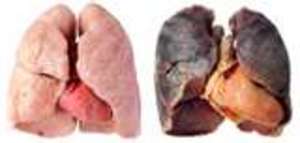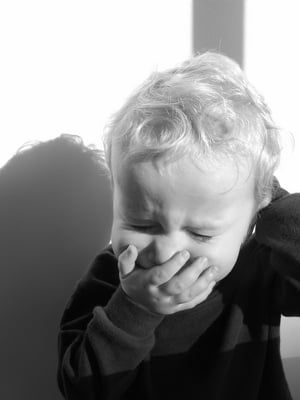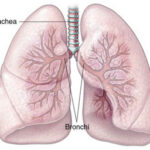Emphysema is one form of chronic obstructive pulmonary disease (COPD) that is characterized by long term shortness of breath, severe shortness of breath on exertion, wheezing and sometimes coughing, when emphysema is accompanied by another form of COPD, which is bronchitis and asthma. When emphysema is advanced or is exacerbated by another chronic lung disease, the patient may have extreme difficulty in breathing, due to the inability to exhale air out of the lungs.
The onset of emphysema is so slow and insidious that irreversible lung damage has occurred before the patient is diagnosed, in many cases. There is no cure for emphysema, and treatment is mostly palliative, since it focuses on treating the symptoms. Medications, such as bronchial dilators open the airways slightly to make more room for air to pass back and forth through the respiratory tract, which makes it less difficult to breathe.
Normally breathing is an act that you don’t have to think about. It happens without having to command your chest muscles to move. The patients with emphysema, however, have to work very hard to contract their chest muscles to force the air out of the lungs. After a few minutes of laboring to breathe, it gets very painful. I know it is painful because I have labored to breathe many times.
I was a smoker for 34 years, and I developed COPD over time. I not only had emphysema, but I also had chronic bronchitis and asthma. COPD, for me, meant that I could not walk and breathe at the same time. I required oxygen therapy by nasal cannula around the clock. I was always attached to either an oxygen concentrator-or it I was out somewhere I used a little portable tank.
When I got sick-due to a cold or flu-my emphysema got worse because it was almost impossible to exhale the air out of my lungs. I could breathe in easily, but I couldn’t breathe out. I became so physically exhausted that I was suffocating. My body had turned a dusky color, and I was blue around my mouth and my hands, fingers and feet. My inability to breathe became a medical emergency.
Normally, when you breathe air goes into your lungs via your trachea from your nose or mouth. The air then travels down two branches called bronchi and into even smaller branches called bronchioles, and finally into tiny air sacs called alveoli. These structures resemble an up-side-down tree, and are known as the bronchial tree. It is in the alveoli (the air sacs) that gas exchange takes place. The alveoli are outfitted with tiny capillaries that pick up oxygen from the air sacs and carbon dioxide is removed from the blood. The alveoli expand and deflate just like balloons when they are inflated and deflated.
In the lungs of an emphysema patient, the alveoli lose their elasticity and become stiff. The bronchioles-tiny branches of the bronchial tree-collapse trapping the air in the alveoli. The alveoli, as a result become over stretched-and some of the pop just like an over-filled balloon. Because of the obstruction from the collapsed bronchioles, the patient is unable to exhale the air that is trapped within the lungs. The ruptured alveoli compromise lung function due to the decreased surface area for gas exchange.
Smoking is the number one cause of emphysema. Emphysema is a progressive, and in most cases a self-inflicted disease, unless you got it by other means other than smoking cigarettes. People who don’t smoke, but live with people that do smoke have been known to develop emphysema from passive smoking.
In rare cases, emphysema is caused by a genetic anomaly, in which the patient inherited a defective gene. The defective gene causes the body not to produce an essential protein called alpha-1-antitrypsin (AAt) that is necessary for normal lung function. AAt is essential to maintain elasticity of the alveoli, without this essential protein the air sacs would become brittle and break. If you have this form of emphysema, your doctor will prescribe protein therapy, in which the protein AAt is administered as an intravenous infusion.
If you are experiencing any of these symptoms: shortness of breath, especially during exertion; wheezing; coughing up sputum that is colored or has a foul odor; or have trouble breathing when lying flat, see your doctor as soon as possible. If you truly are having to labor to get your breath out of your chest and you are in respiratory distress do not wait, dial 911-this is a respiratory emergency. These signs and symptoms do not confirm that you have emphysema, but they do indicate your lungs are compromised.
Your doctor will do a history and physical on you and he/she may also order lab tests, one of which is an arterial blood gas (ABG) that measures the concentration of oxygen and carbon dioxide dissolved in the blood. The doctor, nurse or technician may also place a device-pulse-Ox-meter-on your finger that will give a quick reading of the oxygen concentration in your blood. Your doctor will send you for X-rays of your chest-front view and side view-to visualize the lungs for presence of fluid in the lung, and to rule out any other presence of lung disease, such as pneumonia. Your doctor may also ask you to submit to a pulmonary function test (PFT) to measure the capacity of air your lungs can hold, and the amount of gas exchange between your alveoli and capillaries within your lungs.
The most important step in treatment is the lifestyle changes you will have to make. If you smoke, you will need to stop. If you are having difficulty stopping, ask your doctor about nicotine replacement products, they may be beneficial in curbing your cravings for cigarettes. Your doctor may prescribe respiratory therapy in the form of supplemental oxygen, breathing treatments, and medications such as bronchodilators and steroids that can be either taken by mouth or inhaled.
If you have emphysema, this exercise will help you breathe more easily: purse your lips to where they almost touch each other. When you exhale through pursed lips you will make an s-s-s-s-s sound. Exhaling with pursed lips allows for pressure to hold open the bronchioles that normally collapse trapping the air in the lungs-allowing air to slowly leave the lungs.
There is no cure for this disease, but you can get much better with lifestyle changes. It’s up to you to maintain good nutrition, keep your weight within normal limits-being overweight demands more oxygen. Find ways to cope with your disease. Don’t be afraid to accept the support form your family and friends. Talk about what you are feeling. It may help you to locate a support group in your area. To find a support group contact your local chapter of the American Lung Association.
Source: Mayo Clinic information page




